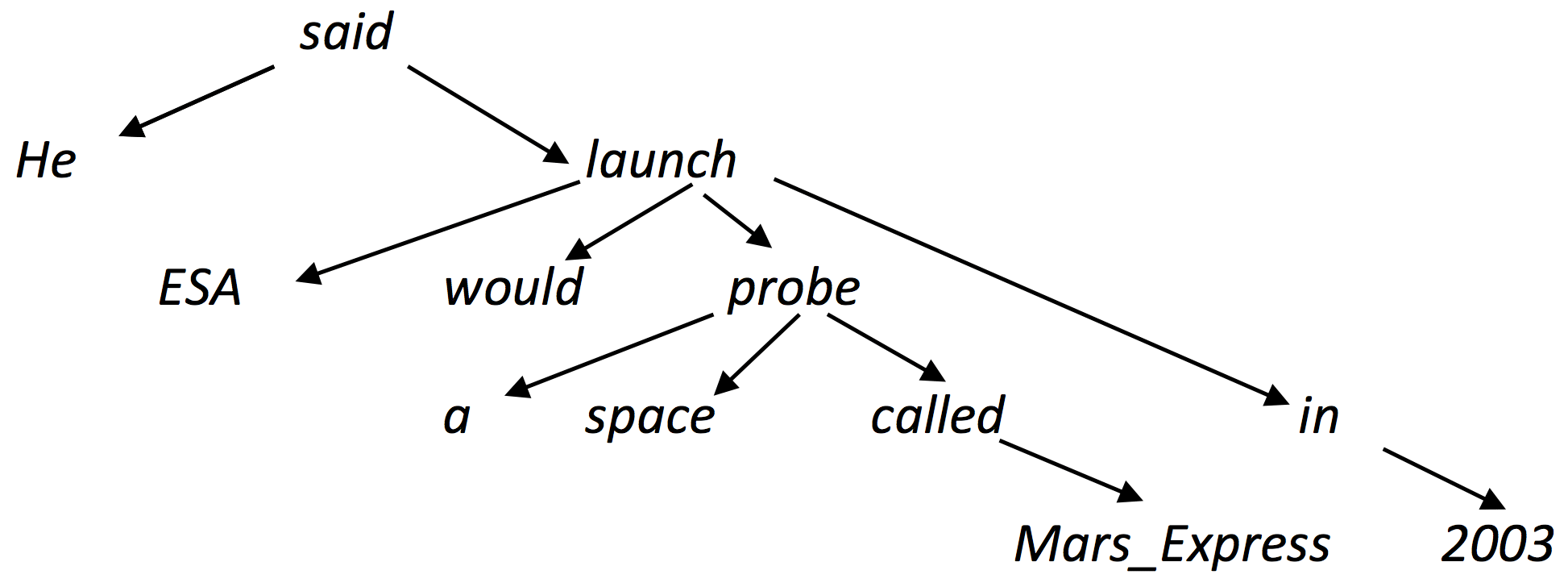Syntax
"How to put words together"
"How to put words together"
Syntax deals with the linear structure of language, trying to explain how words (the minimal units of syntax) interact in forming a sentence (the maximal unit of syntax).

Individual words as well as more complex structural parts of a sentence can all be described in terms of form, that is what they are or consist of, and function, what their role in the sentence is. In the sentence The European space agency launched a space probe to Mars in 2003, for instance, there are five constituents, indicating who did (launched) what, as well as where and when. The core constituent is the verb launched, which directly controls the who and what arguments (called subject and object in syntactic theory), and more loosely the time and place satellites (called adverbials). Such functional constituents can be thought of as slots to be filled with material of varying syntactic form. Thus, the subject the European space agency is a is not only a great alternative to NASA, but also a group of words, called a noun phrase (np) because it is headed by a noun, and because it can be replaced with a simple (proper) noun, ESA, or nominal pronoun, it. While all languages can express who-did-what-when-where, they do so in wildly divergent ways in terms of constituent order (Typology).
Most modern syntactic theories use tree structures to describe syntactic relations, either between constituents (generative grammar) or between tokens/words (dependency grammar).
Generative grammar (or phrase structure grammar, PSG) is so named because it allows for the generation of a sentence by iterative (repeated) groupings of constituents (phrases), based on rewriting rules:
A corresponding dependency tree would look like this:

At the surface level, syntactic function may be marked by morphological features (Morphology), such as affixes, by word order or by separate function words (such as prepositions/postpositions in European languages or post-particles in Japanese).

| syntactic function | subject | predicator | indirect/dative object | direct object | indirect/prepositional object | predicator |
|---|---|---|---|---|---|---|
| case | dative | accusative | ||||
| German | Das Kind | hat | dem Hund | Wasser | gegeben | |
| Esperanto | La infano | donis | akvon | al la hundo | ||
| English | The child | gave | water | to the dog | ||
| Japanese | kodomo ga | mizu o | inu ni | yarimashita |
Synthetic languages (Morphology) not only mark relations between constituents, but often also provide a visible link between words within a constituent. The best example for this is noun phrase agreement, where all the words of a noun phrase share the same number, gender and case (see for example Lingvopedia noun boxes for Slovak, German etc.). The Portuguese noun phrase as novas casas (the new houses), for instance, explicitly agrees on both number (plural) and gender (feminine) for all three of its constituent words. However, and exactly because agreement is so basic a concept, the ambiguity or absence of such markers on some of the words is allowed, as long as at least one word retains the necessary information. Thus, the case marker of a German noun phrase is more visible in the article than in the noun (der Hund, des Hundes, dem Hund, den Hund), and English marks the plural only on nouns, not on adjectives or articles.
At a deeper level, syntactic structure reflects the meaning structure (semantics) of an utterance. Active and passive, for instance, are two ways of expressing the same underlying statement. Thus, the cause-effect relation (semantic roles, cp. Semantics chapter) between earthquakes and tsunamis remains the same even when tsunamis is made the subject of the sentence:

| 1. argument slot | Verbal head | 2. argument slot | |
|---|---|---|---|
| Active | Earthquakes | may cause | tsunamis |
| Syntactic function | Subject | Predicator (active) | Object |
| Semantic role | CAUSE | EFFECT | |
| Passive | Tsunamis | may be caused | by earthquakes |
| Syntactic function | Subject | Predicator (passive) | Adverbial (agent of passive) |
| Semantic role | EFFECT | CAUSE |
It remains unclear if linguistic structure, at any level, directly reflects cognitive processes, but it is known that humans have a special syntactic brain center, the Broca center, in the motor part of the frontal lobe. This part of the brain is distinct from the Wernicke center, which handles the linking of sound and meaning, and is located in the temporal lobe, where hearing is processed. Patients who suffer from Broca center stroked will speak in a telegram style, simply chaining nouns without function words or syntactic trees, but the result will make sense. Conversely, Wernicke patients will produce syntactically fluent nonsense.
However, it may well be fluent nonsense that distinguishes human speech from primate speech. Bonobos, in particular, are capable of learning sign language, understand complex spoken questions and even combine words in creative ways (please open hurry = please open [it] quickly). But they have only very rudimentary (Wernicke style) chaining syntax and do not perform transformations such as questions.